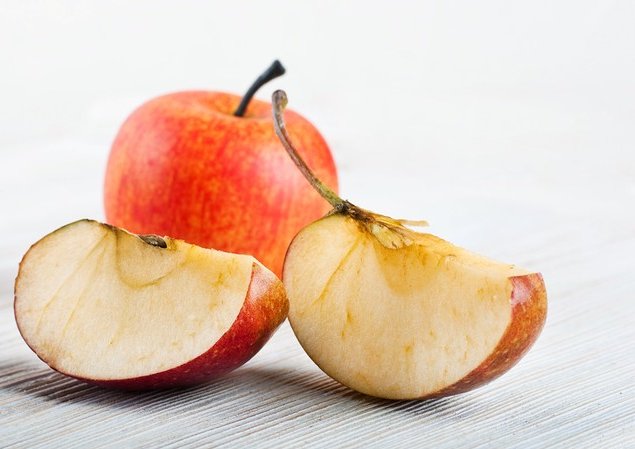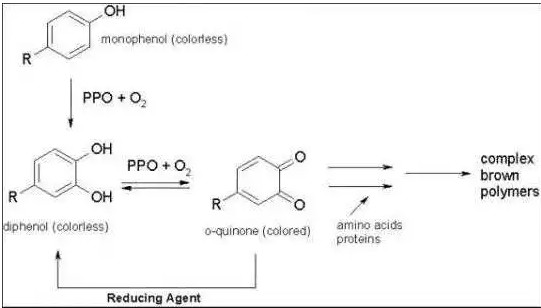Why do apple pieces turn brown after cutting?
Not only is it an aesthetic disadvantage, this problem also causes significant damage to the market and the food industry.
Why are the apple pieces brown?
Apples, they are delicious but will be rejected to be included in the menu of any party. It is a fact that few people notice, however, it is easy to understand why: apple pieces will quickly turn brown after cutting. Not only is it an aesthetic disadvantage, this problem also causes millions of pieces of apples to be discarded each year, causing significant damage to the food market.

The pieces of apples will quickly brown after cutting.
Why are the apple pieces brown?
When you cut a piece of apple in half, a number of cells on either side of the cut will be halved or broken. This process releases an enzyme called Polyphenol oxidase . It is not worth mentioning if it is stable and inert in the air at room temperature because Polyphenol oxidase is a colorless substance.
However, the problem is that this enzyme will quickly combine with oxygen in the air to create a new compound called o-quinon . O-quinon, itself is not brown in color but when it continues to react with amino acids and oxygen in the air, this process produces melanin. Finally, melanin is produced by plants like apples and bananas, which are brown in color, similar to melanin that makes your hair and skin color.

Chemical equations explain the process of browning in apples.
Many other plants also undergo this process, but in a more positive direction. According to Scientific American, the taste and color of coffee and chocolate are made similar to the browning process in apple pieces.
You may ask why is this process happening? What must have their purpose.The browning of the apple is actually a mechanism to protect it against bacteria and fungi . Besides, according to BuzzFeed, apples have been 'learned' from the evolutionary process. Because when browning, apple meat will be softer, thereby facilitating seed easily falling from the fruit and germinating.
A brown color also causes problems
Maybe you think the problem is very simple, I still eat these pieces of apple and their taste doesn't change. Is someone complicating the problem of saying brown apple pieces affect the food market?
The answer is no. Many of us have picky and sophisticated personalities. When talking about brown apple pieces, especially children, they are willing to put an apple plate in the trash when a change in color is detected.
On an industrial scale, the apples will be put aside in the packaging process if 'they are chipped or have an eye-catching color, even though they are good apples , ' Dave Henze comes from. Holtzinger Fruit company said. Only a few chipped apples are pricked and transferred to the packaging or juice production department. 'Every day, a lot of food has been wasted like that,' said Dave Henze.

A brown apple does not cause problems but millions of fruits do.
According to a report by the United Nations Food and Agriculture Organization and Consumer Affairs, billions of dollars have been lost through the decline in the value of fruits and vegetables . If the apples, potatoes, bananas and avocados don't turn brown, the industry and the food market can pull back a huge sum of money.
And in fact, that's also the idea of being realized by Okanagan Specialty Fruits, a Canadian company.By genetic modification, they created unrefined apples in the air.
Solution should be accepted
Apples called Arctic Golden Delicious are created by Okanagan Specialty Fruits by genetic modification, which does not turn brown in the air . In February 2015, this apple variety was approved by the US Department of Agriculture for sale on the market.
Arctic Golden Delicious apples are not browned by scientists who have implemented an RNA interference mechanism. A special type of RNA can interfere with genes that lead to browning of apples.
In order to make these apple trees produce this type of RNA, Okanagan Specialty Fruits injects additional copies of the genes that make browning apples. However, these copies have been customized to interfere with the apple browning mechanism. Then both natural and artificial genes will be disabled, making the apple pieces retain their color.
Okanagan Specialty Fruits has spent $ 5 million over two decades to create these colorless apples. Practical research is very expensive, however, it is promised to be a solution to the significant waste in the current food waste problem.

The Arctic Golden Delicious apples are not browned (below) compared to regular apples (above).
Even so, Okanagan Specialty Fruits has not dared to sell special apples. The problem is that they have to convince consumers. Many people still have doubts about choosing genetically modified food for their meals.
So in the meantime, you may need some tips to keep normal apple pieces from browning. Spraying a little lemon juice outside the apple can reduce oxidation and keep the apple from changing color. However, no one will enjoy a piece of apple with lemon flavor.
Try another way, such as plastic wrap outside them or store in a refrigerator if possible. Soaking apples in hot water can also denote polyphenol oxidase and inhibit browning.

If browning is not done, the apple will look better.
Even so, the Arctic Golden Delicious apples of Okanagan Specialty Fruits are still the best choice for luxurious banquets. Non-brown apple pieces, not wrapped in nylon and especially tasteless of lemon juice will make many guests enjoy and feel your sophistication.
- Why does the cut apple turn brown?
- It turns out we all wash the cutting board the wrong way
- Discover Apple's $ 5 billion headquarters
- Wooden cutting boards are proven cleaner than plastic cutting boards
- Beautiful creative paper cut art like fairy
- Will apple skin helps to prevent obese?
- The world's first yellow fleshed apple apple
- Close up of the magnificent 'spacecraft' of Apple's 1-0-2
- Ancient apple trees spread out with 10 football fields
- Chicken quarry cutting - Measures should be applied in industrial animal husbandry
- Turn your iPhone into a smart indoor control device
- Amazingly explore the mysterious nature of brown dwarfs
 Why do potatoes have eyes?
Why do potatoes have eyes? 'Tragedy' the world's largest carnivorous life: Death becomes ... public toilet
'Tragedy' the world's largest carnivorous life: Death becomes ... public toilet Tomatoes were once considered 'poisonous' for 200 years
Tomatoes were once considered 'poisonous' for 200 years Detecting microscopic parasites on human face
Detecting microscopic parasites on human face